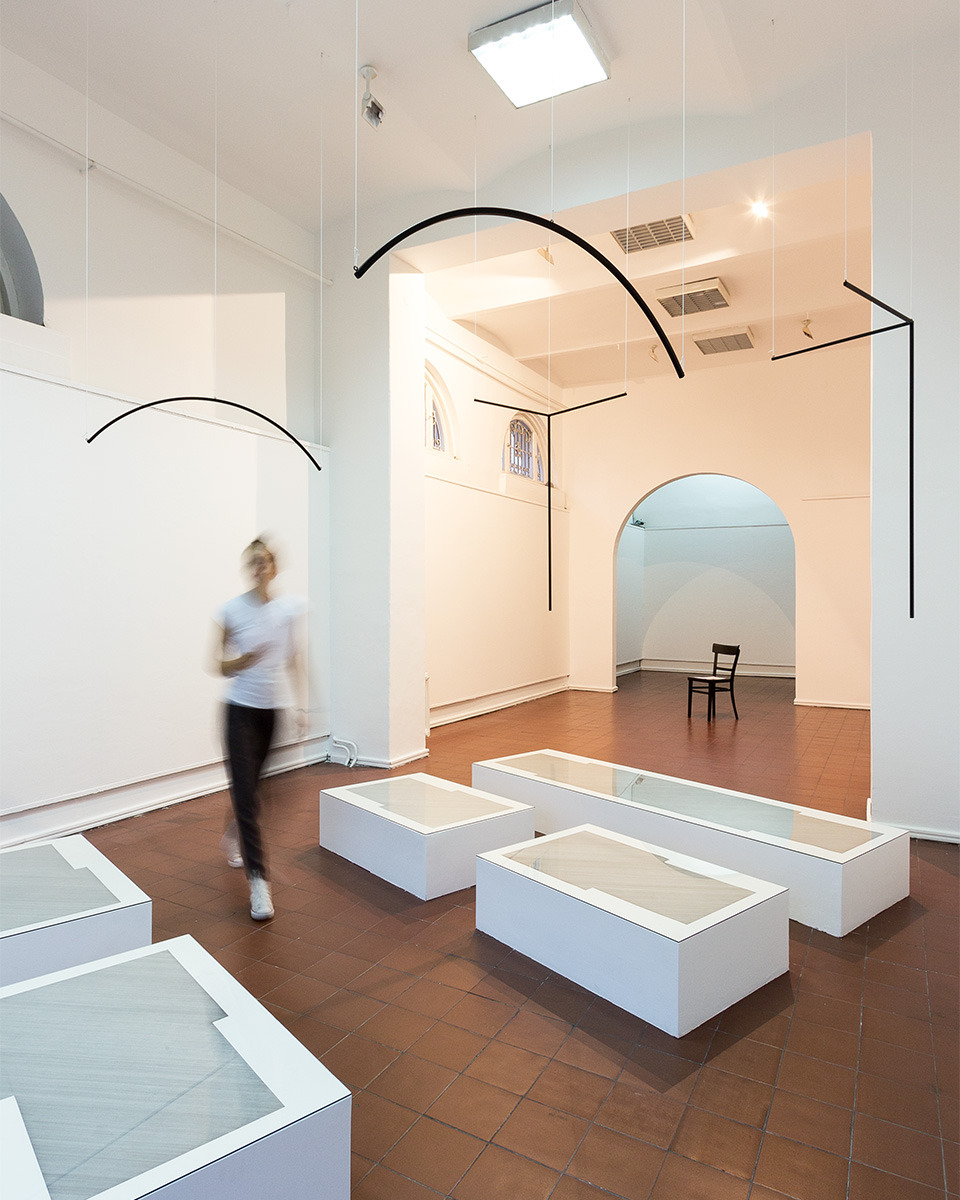Triumphal Arch
Visual Arts
Visual Arts

Ivan Šuletić & Petokraka
Triumphal Arch, 2014
(installation, drawing)
Faculty of Fine Arts (FLU) Gallery, Belgrade, Serbia
Triumphal Arch, 2014
(installation, drawing)
Faculty of Fine Arts (FLU) Gallery, Belgrade, Serbia

What is (used to be) a Monument?
Text by Ana Bogdanović
Text by Ana Bogdanović
The attitude of a culture towards
monuments is reciprocal to its approach to the past – this relation is a tautological starting point of a large number of attempts to understand the importance of remembering the past in the present regimes of collective and political self-descriptions. If we get an insight into the articulation of modernity through the ways of construction of historical narratives, it becomes clear that today’s unstable, uncertain and helpless position of culture and society is a consequence of the inability to identify the messages and lessons from the past and perform them in the current circumstances. This does not mean that it is regrettable that we have abandoned the heroic, victorious narratives of the past that – being embodied in durable sculptural and architectural representations – shaped public spaces, reviving again the famous
historical episodes as fulcrums of imaginary collective identity.
Situation in which we now build our attitudes towards the past is not a place of Romantic escapism but a space of the uneasy presence of the past, experience and memories which, it seems, we cannot cope with. What monuments do we need today, then?
A Roman arch, understood as one of the first images of direct and indirect transferring of events in the (epic) history and unquestioned memory, is constructed here as an open structure, with no ornamental or monumental aspirations, in order to examine performative and participatory potential of the monument. The reduced spatial organization and the emphasis on the objectness versus symbolic and didactic quality of memorial architecture abolishes representational, passive model of reception and seeks to actively engage the viewer’s body in the indicated event which will not give them a predetermined role but leave a reflection of the perceived to their experiential sensibility. The change from the expected to the unfixed manifestation of materialized past initiates a question of sustainability of the inherited glorifying historical narratives and, which is more important related to the initial question, leads us to reconsider the basis on which we build our position in the interweaving of past and present.
If a monument used to be a safe place of historical presence in time, can we imagine it today as a space of activity in the current trends?
A Roman arch, understood as one of the first images of direct and indirect transferring of events in the (epic) history and unquestioned memory, is constructed here as an open structure, with no ornamental or monumental aspirations, in order to examine performative and participatory potential of the monument. The reduced spatial organization and the emphasis on the objectness versus symbolic and didactic quality of memorial architecture abolishes representational, passive model of reception and seeks to actively engage the viewer’s body in the indicated event which will not give them a predetermined role but leave a reflection of the perceived to their experiential sensibility. The change from the expected to the unfixed manifestation of materialized past initiates a question of sustainability of the inherited glorifying historical narratives and, which is more important related to the initial question, leads us to reconsider the basis on which we build our position in the interweaving of past and present.
If a monument used to be a safe place of historical presence in time, can we imagine it today as a space of activity in the current trends?

Background
FLU Gallery in Belgrade opens the summer program FLUisms with the exhibition cycle Moment for Monument!, which presents young authors and their works on the phenomenon of monumentality.
The FLUisms concept raises a series of questions about size as an aesthetic norm and the relationship with the observer. Does a work exhibited in the gallery automatically become monumental? Does it have to be of colossal proportions to receive that epithet? Is it enough to be big or clean to be monumental? Is big automatically important, or can it be intimate if oversized? What is monumentality today? Do we shrink in front of great works? Do they bring us back to childhood, when we were small in front of something? Are we more touched by the great, or are we distanced from the imposed colossal? Is a great work automatically 'high' art? What is great, and what is wrong with pretentious grandiosity? Does it all make sense today, and are we covering up small or large flaws in the bulkiness?
— Excerpt from the FLU Gallery curatorial statement 1
The FLUisms concept raises a series of questions about size as an aesthetic norm and the relationship with the observer. Does a work exhibited in the gallery automatically become monumental? Does it have to be of colossal proportions to receive that epithet? Is it enough to be big or clean to be monumental? Is big automatically important, or can it be intimate if oversized? What is monumentality today? Do we shrink in front of great works? Do they bring us back to childhood, when we were small in front of something? Are we more touched by the great, or are we distanced from the imposed colossal? Is a great work automatically 'high' art? What is great, and what is wrong with pretentious grandiosity? Does it all make sense today, and are we covering up small or large flaws in the bulkiness?
— Excerpt from the FLU Gallery curatorial statement 1
Creative Practice — Petokraka
In Perth, Western Australia
and Belgrade, Serbia
In Perth, Western Australia
and Belgrade, Serbia